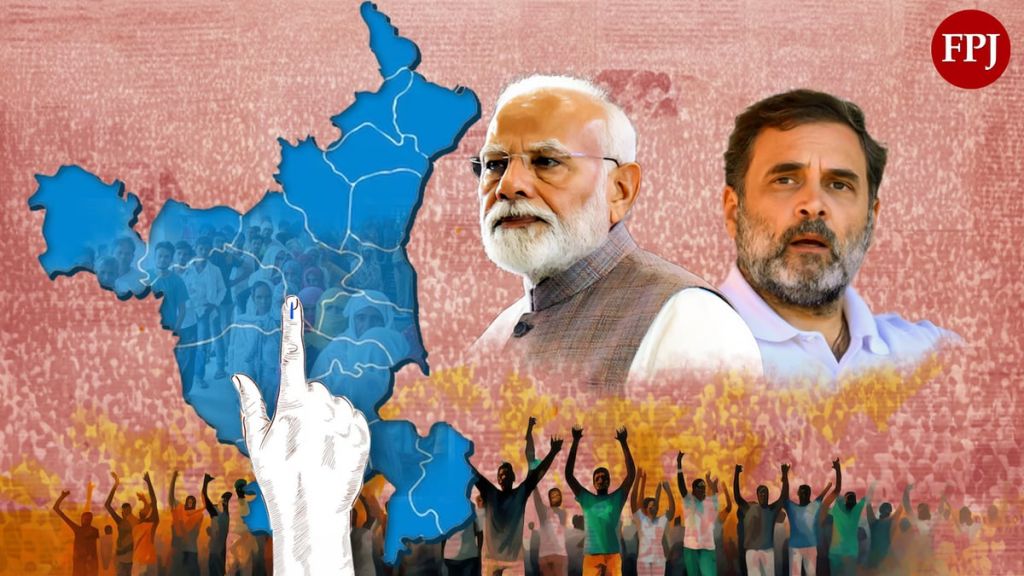
Gurugram: The political scenario in the Haryana assembly elections of 2024 was marked by a surprising victory for the BJP despite waning backing for its national leadership. This analysis looks at the factors influencing the BJP's success, the evolving electoral landscape, and the obstacles encountered by the Congress.
Fewer Efforts Than 2014
Since 2014, the BJP initially secured a majority in Haryana with Prime Minister Narendra Modi at the helm, the party has heavily depended on his charm and public events. Modi's series of ten rallies in 2014 resulted in the BJP gaining 47 out of 90 assembly seats, propelling the party from a small player to the leading power in the state. In 2019, despite gaining more recognition nationally, Modi decreased his number of rallies to six while still retaining power by creating a coalition government with the Jannayak Janata Party (JJP).
Campaigns Led By Party Leaders
During the assembly election campaigns in Haryana, Congress leader Rahul Gandhi conducted 12 rallies, whereas PM Modi only conducted 4 rallies. The BJP emerged victorious in regions where they campaigned and also secured seats in areas where Gandhi campaigned.
Haryana Election Result 2024: मनोहर लाल खट्टर का पहला रिएक्शन- 'जनता ने कांग्रेस को नकार दिया' pic.twitter.com/i0BjqTQB0u
— Zee Bihar Jharkhand (@ZeeBiharNews) October 8, 2024
Constituencies campaigned by the leaders and wins:
Gohana: Campaigned by Congress, Won by Arvind Kumar Sharma (BJP)
Karnal: Campaigned by BJP, Leading candidate Jagmohan Anand (BJP)
Kharkhauda: Campaigned by Congress, Won by Pawan Kharkhoda (BJP)
Ladwa: Campaigned by Congress, Leading candidate Nayab Singh (BJP)
Mulana: Campaigned by Congress, Leading candidate Pooja (INC)
Naraingarh: Campaigned by Congress, Won by Shalley Chaudhary (INC)
Nuh: Campaigned by Congress, Won by Aftab Ahmed (INC)
Palwal: Campaigned by BJP, Won by Gaurav Gautam (BJP)
Shahbad: Campaigned by Congress, Won by Ram Karan (INC)
Sonipat: Campaigned by both parties, Won by Nikhil Madaan (BJP)
Thanesar: Campaigned by Congress, Won by Ashok Kumar Arora (INC)
Yamunagarh: Campaigned by Congress, Leading candidate Ghansham Das (BJP)
The Change In Campaign Tactics
Unlike previous elections, Modi held just four rallies before the 2024 elections. Political experts believe this indicates a change in strategy caused by increasing anti-incumbency feelings and internal factors within the BJP. According to Jyoti Mishra from the Centre for the Study of Developing Societies (CSDS), there has been a change towards prioritising local candidates over national figures, showing a move towards grassroots campaigning that focuses on local issues and community involvement.
#ElectionsWithHT | #Haryana CM and BJP leader @NayabSainiBJP wins from #Ladwa. He defeated Congress' #MewaSingh by a margin of 16,054 votes.
— Hindustan Times (@htTweets) October 8, 2024
Track all the latest updates of #HaryanaElectionResult here: https://t.co/Ynmzbboqjl#HaryanaElections #NayabSinghSaini pic.twitter.com/srIh0IxOjy
Challenges of Anti-Incumbency
Political analyst Kushal Pal points out that the BJP is well aware of a prevalent sentiment of strong anti-incumbency among voters. The decline of the party from 47 seats in 2014 to 40 in 2019 showed diminishing support, worsened by a shortage of new leadership. Modi's dwindling rallies may be a reaction to these challenges, indicating that the BJP had to change its strategy to remain relevant.
Key Factors Leading To BJP's Win In Haryana
In the face of these obstacles, the BJP was able to achieve success by leading in 50 seats as the results came in. Numerous elements played a role in this unexpected result.
Influence Of Jat Community
The Jat community, traditionally a powerful voting group in Haryana, was predicted to unite in support of the Congress party under the leadership of Jat leader Bhupinder Singh Hooda. Nevertheless, this division did not fully occur, as the BJP won 19 out of the 36 seats where Jats are the majority. Analysts observed that although it was anticipated for Jat votes to support the Congress, not all of them voted together, which enabled the BJP to make progress in key areas.
Loyalty From Ahirwal
The BJP continued to have a strong influence in the Ahirwal area, which is recognized for being loyal to the party. In past elections, this area consistently backed the BJP and its strong support continued in 2024. The cities, especially Gurugram, also provided significant support to the BJP, boosting its overall success.
Leadership Led By Nayab Singh Saini
Nayab Singh Saini, who was named Chief Minister of Haryana just one year before the election, had a pivotal role in bringing together the party's front. On the other hand, the Congress experienced a lot of internal conflict, with various leaders competing for influence and control. The BJP's strong communication and consistent leadership stood out in comparison to the chaos in the Congress party.
Congress's Internal Politics
The Congress Party did not meet expectations, as they were unable to take advantage of the anti-incumbency feeling towards the BJP. The party's efforts were greatly hindered by internal power struggles. The rivalry between figures such as Bhupinder Singh Hooda and Kumari Selja for candidacy and the position of Chief Minister led to evident discord, hurting the party's cohesion. This inner turmoil compromised their campaign and prevented them from putting forward a united front to voters.
Haryana Assembly Election Result 2024 : हरियाणामध्ये काँग्रेसची 61 जागांवर आघाडी, जल्लोषाला सुरुवात#Maharashtra #Haryana pic.twitter.com/ddphtbBqDn
— ABP माझा (@abpmajhatv) October 8, 2024
Attention To Local Issues
The 2024 elections underscored a significant shift in voter priorities, with local issues taking precedence over national narratives. Voters demonstrated a clear preference for local leadership and solutions tailored to regional concerns. This trend forced the BJP to recalibrate its campaign strategy, emphasising local representation over Modi's national persona.